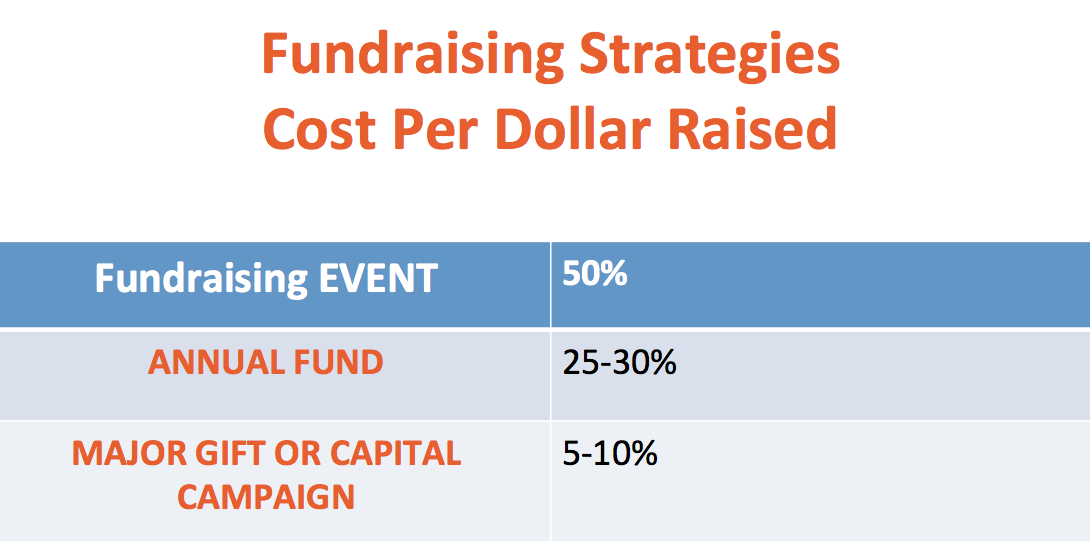Fundraising Events – Are You Having Too Many?
How many fundraising events does your nonprofit put on each year?
I imagine that you are staging 2-5 events a year, of various sizes and purposes.
Maybe even more.
So who plans and executes all these events?
It’s, of course, volunteers and/or your development office staff.
I’m not so sure fundraising events are the best place to focus your staff’s time.
When you focus your staff resources on an event, you are taking time away from other productive, MORE profitable fundraising activities such as:
Receive expert advice. Direct to your inbox. Subscribe
- developing relationships with major donors
- sending out solicitation mailings
- building donor loyalty
- getting out email solicitations
The fundamental question is: “what’s the best use of your staff resources?”
Many organizations are considering scrapping their galas altogether. Or they are turning their galas upside down with a new focus.
Here’s something to consider: Is it really worth it all?
What’s the “opportunity cost” of your time?
There’s a huge opportunity cost of spending time on a less profitable fundraising event when you could be using that same time on more profitable activities.
Here are three fundamental truths about events that every nonprofit needs to recognize.
1. Events are not very efficient fundraising strategies.
Simply put, you can raise more money with other fundraising strategies.
The ROI you get from an event is far less than other kinds of fundraising.
Find out how we can help you achieve your fundraising goals with world-class consulting and custom training.
Looking at the chart above, and take a look at the costs of an event and compare them to the cost of a direct mail solicitation campaign, where the cost per dollar raised is only $.25-.30 cents on the dollar.
It’s interesting to note that the most efficient way to raise money of all is face-to-face solicitations focusing on major gift donors – that’s only $.05 -.10 on the dollar. :) That’s my sweet spot!
2. Too many fundraising events will KILL your volunteers and your staff.
I think nonprofit staffers work awfully long hours. I find that they are often overworked, underpaid and certainly not appreciated enough.
WHY would you ask them to spend vast amounts of time and energy on something that offers such a low return on their effort?
And your dedicated well-meaning volunteers can easily get worn out too, if you work them too hard. They will abandon ship!
There are easier ways to raise friends and raise money for your cause.
3. You can raise more money with one annual event than with 3, 4 or 5 events.
Why? The real money from an event comes from sponsorships.
If you organize your sponsorship effort right, then you can secure major high dollar sponsors.
But to be successful in sponsorships, you have to have enough lead time.
Many businesses do not make these major decisions quickly.
It takes a decent lead time to:
- develop sponsorship materials,
- target the right prospects,
- organize a committee,
- make the asks,
- then you have to close the asks.
Then you need the lead time to get their names on the printed invitation.
That’s a 9-12 month planning cycle, isn’t it?
Why should you cancel some of your events?
Because If you focus all your energy on one major event each year, you can raise bigger sponsorships, because:
- you have enough lead time to develop and close major sponsorships
- focusing on a huge, well-produced single event each year highlights your organization
- you can create visibility and pizazz – you are not spreading everyone’s attention thin.
Don’t get me wrong – many fundraising events are fine.
They can be a very important part of a full-scale fundraising program.
But just don’t overemphasize them.
A well-balanced fundraising program for any nonprofit focuses on several different revenue streams from mailings, email, grants, and major gifts, as well as events.
If you only stage ONE major fundraising event a year:
1. Your volunteers can go all out in spreading the word and generating attendance, because they are only going to focus on one a year.
2. You have the lead time you need to identify, cultivate, and ask major sponsors.
3. You’ll have greater attendance and attention from your supporters.
4. You’ll be able to raise more money overall because the staff has time to focus on other more profitable fundraising strategies.
5. You’ll have a happier and more productive staff.
BOTTOM LINE
Just be smart about where you focus your time and energy.
You are trying to change the world.
So be efficient. Go where the money is. Get there as quickly as possible
Conserve your energy and put it in the most productive places possible.
And don’t forget – if you DO want to make your fundraising event wildly profitable and bring in the most money possible, then get hold of our Highly Profitable Fundraising Events Classes.
What do you think?
Leave us a comment and let us know!






So important. At my small shop we have one annual gala (that I’m hoping I can kick out of the cycle eventually), but any smaller events are organized by someone else — benefit concerts or auctions, or becoming a team in a like-minded org’s run/walk that can drive dollars to us.
Yes yes – do the dollars equal the effort? Not 100% sure! Gail
I used to work in the special events end of fundraising. Events are a lovely way to cultivate and steward donors. They have the potential to be a great exposure for your organization. They are a terrible way to raise money. Period. You should probably do the obligatory annual gala, but skip the rest and focus your energy on other options.
Hi Valerie! Thx for weighing in. Yup to gaining exposure. Yup to events as a terrible way to raise money!